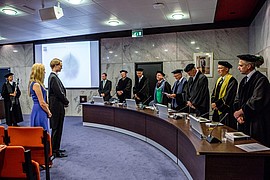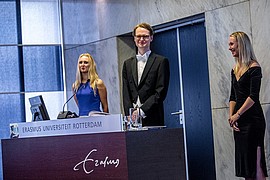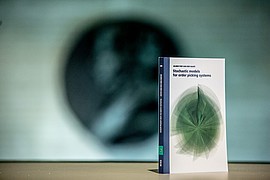PhD Defence: Jelmer Pier van der Gaast

In his dissertation ‘Stochastic Models for Order Picking Systems’ ERIM’s Jelmer Pier van der Gaast develops new stochastic models for the performance evaluation of two state-of-the art order picking systems: zone picking and polling-based milkrun picking.
Jelmer defended his dissertation in the Senate Hall at Erasmus University Rotterdam on Thursday, 8 September 2016 at 13:30. His supervisor was Prof. M.B.M. de Koster and his co-supervisor was Prof. I.J.B.F. Adan. Other members of the Doctoral Committee were Prof. R. Dekker (ESE), Prof. -ing. K. Furmans (KIT) and Dr J.A.C. Resing (TUE).
About Jelmer Pier van der Gaast

Jelmer Pier van der Gaast was born in Rotterdam (The Netherlands) on July 21, 1988. He completed grammar school at the RSG Hoeksche Waard, Oud-Beijerland in June 2006. In October 2010 he received his master’s degree in Econometrics and Management Science with distinction from Erasmus University Rotterdam. In 2011 he joined the Management of Technology & Innovation group at the Erasmus University Rotterdam.
His research interests include: warehouse operations, stochastic processes, and queueing theory. His research findings have been presented in many international conferences including INFORMS Annual Meeting, European Conference on Operational Research, SMMSO Conference on Stochastic Models of Manufacturing and Service Operations, and International Material Handling Research Colloquium.
Thesis Abstract

Order picking, the process of retrieving customer orders from their storage locations, is the most critical operation in a warehouse. Any under performance in order picking can lead to unsatisfactory service and high operational cost for the warehouse, and consequently for the whole supply chain in which the company operates. This thesis develops new stochastic models for the performance evaluation of two state-of-the art order picking systems: zone picking and polling-based milkrun picking. These models adequately describe and predict the consequences of variability on the performance of these warehousing systems.
The first part of the thesis zone picking systems are studied, one of the most popular conveyor-based picker-to-parts order picking methods used in practice. We model the various elements of the system including conveyor merges as a network of queues with multiple order classes, with capacity constraints on subnetworks, and with the dynamic block-and-recirculate protocol. The resulting model is most suitable to support rapid and optimal design of complex zone picking systems. In the second part of the thesis, milkrun picking systems are investigated. In this system an order picker picks multiple orders that arrive in real-time and integrates them in the current picking cycle. This subsequently changes dynamically the stops on the order picker’s picking route. Using polling models, we study order throughput times for various picking policies, and the effect of product allocation. The results of the model show that when the order arrival rate is high milkrun order picking significantly improves system performance compared to conventional batch picking. In addition, the best product allocation improves the order throughput time considerably.
Photos: Chris Gorzeman / Capital Images


